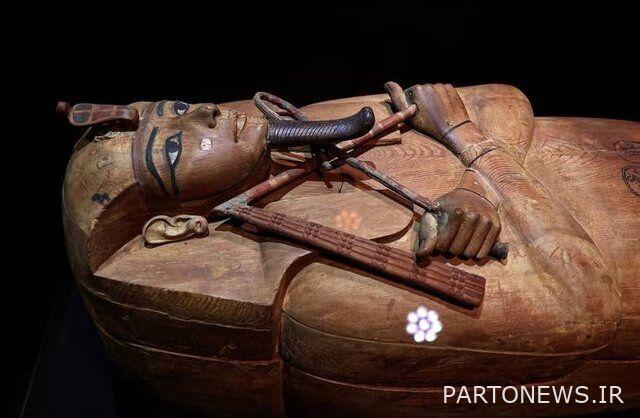Pharaoh went to France with a passport

According to Moj news agency, “Ramses II” may be one of the biggest and most famous Pharaoh called ancient Egypt. He was the third pharaoh in the 19th dynasty of Egypt who took the throne at the end of his teenage years in 1279 BC and after the death of his father. Ramses II ruled ancient Egypt for a total of 66 years and is believed to have had more than 100 children. During his long reign, this pharaoh won numerous military battles and built many monuments to the gods and himself.
One of the successes of “Ramses II” was the victory in the “Battle of Kadesh”. In this battle, the Egyptians under the leadership of “Ramses II” fought with the Hittites over the control of Syria. This battle took place in the spring of the fifth year of Ramses II’s reign.
“Ramses I” was the grandfather of “Ramses II”, whose ordinary family raised them to royal ranks with their military prowess. “Seti I” (father of Ramesses II) ensured the wealth of this country by building mines. He also strengthened the fortifications of the northern borders against the Hittites. When Ramses II ascended the throne at the age of 14, the Hittites took the opportunity to measure the young pharaoh and the northern borders of his empire. The Hittites invaded Egypt and captured the important commercial city of Kadesh, which is located in modern-day Syria.
Ramses II sent his forces to Kadesh to recapture this city, but Egypt was deceived and thought that the Hittite forces were stationed further away from the Egyptian camp, while the Hittites waited nearby and finally attacked. . The Egyptians were about to be defeated when the reinforcements arrived at the right time. “Ramses II” won this battle, but he did not win the war. His wounded soldiers retreated from Kadesh, but Ramesses was not about to let a small fact tarnish his earlier success. As a result, he ordered murals to be created on temples throughout Egypt depicting him defeating enemies with one hand.
In fact, Ramesses II signed a peace treaty with the Hittites after years of negotiations. This is the oldest peace treaty whose text has survived. In the terms of this treaty, it is stated that both of them will help each other if they are attacked by foreigners or locals. A copy of this treaty is inscribed in hieroglyphic script on a stone pillar in Karnak Temple. In 1906, its second version was discovered in Akkadian on a clay inscription in Turkey. The importance of this peace treaty is so much that a copy similar to it is displayed at the United Nations headquarters in New York.
As a sign of diplomatic goodwill, Ramses II married the eldest daughter of the Hittite king, and in this way, the king’s daughter joined Neftari, the eldest wife of Pharaoh and the large family of more than 100 children of Ramses II.
The wealth of this pharaoh can be understood by considering the impressive buildings he created. Karnak and Abu Simbel temples are among the most amazing monuments in Egypt. Ramseum, the burial temple built by this pharaoh, includes a huge library of about 10,000 papyri. “Ramses II” also honored both himself and his father by completing the construction of “Abydos” temples.
“Abu Simbel” consists of two temples, known as the Great Temple and the Small Temple, which are carved into the foothills. According to some researchers, the process of building this temple started around 1264 BC. According to the artwork engraved inside the Great Temple, this building was built to commemorate the victory of “Ramses II” over the Hittites in the “Battle of Kadesh” in 1274 BC. It took 20 years to build the Abu Simbel temple. At the entrance of the great temple, four huge statues of “Ramses II” are depicted in a sitting position. The length of these sculptures reaches 20 meters.
In front of the small temple, which was probably built for “Neftari”, two queen statues and four pharaoh statues were built, each of which is 10 meters long.
In the interior of the great temple, there are four statues of “Ra”, “Amun” and “Ptah” of ancient Egyptian gods along with the statue of “Ramses II”. The statue of “Ptah” was kept in the dark, perhaps because this ancient god was associated with the underworld.
Abu Simbel Temple was finally abandoned and buried under the sand of the desert. This building was forgotten until it was discovered in the early 19th century.
After the death of “Ramses II”, his body was buried in a tomb in the “Valley of Kings” and later transferred to the royal tank, which was discovered in 1881. In 1976, the doctor who examined the remains of this pharaoh announced that the pharaoh’s body needed immediate treatment to prevent decay caused by the growth of fungus. For this purpose, “Ramses II” had to go to France. According to French regulations, a valid passport must be presented to enter and transfer to this country, and as a result, the Egyptian authorities issued a passport to this pharaoh.
Currently, Paris is hosting an exhibition entitled “Ramses and the Gold of the Pharaohs” where the wooden coffin of “Ramses II” is on display in a rare event outside of Egypt, along with other notable historical artifacts of ancient Egypt.

